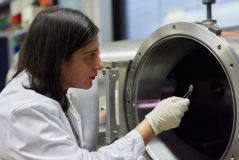MLZ is a cooperation between:
 > Technische Universität München
> Technische Universität München > Helmholtz-Zentrum Hereon
> Helmholtz-Zentrum Hereon
 > Forschungszentrum Jülich
> Forschungszentrum Jülich
MLZ is a member of:
 > LENS
> LENS > ERF-AISBL
> ERF-AISBL
MLZ on social media:

MLZ (eng)
Lichtenbergstr.1
85748 Garching
14.08.2024
How old are you, battery?
Battery capacity loss is among the biggest brakes in e-mobility and the industry. A research team from FRM II and other institutions is now validating a method that can be used to determine the distribution of elements in the anode of a battery and, thus, better understand aging.
It is a common experience that a new cell phone initially gets you through the day on a single charge. But after just a few months, you realise you should take a charging cable to be safe: the battery is aging. The reason for this is usually the loss of free lithium, which is increasingly and irreversibly deposited in a layer on the anode of the battery cell with each charging cycle.
A deep look into the anode
A precise understanding of these effects is crucial to minimise the influence of aging effects on future battery generations. This also includes characterising the depth profile of a sample. In a recent article, researchers from the Heinz Maier-Leibnitz Zentrum (MLZ) and the Zentrum für Sonnenenergie- und Wasserstoff-Forschung Baden-Württemberg (ZSW), among others, have now validated a method that promises to make such investigations more precise and faster to carry out.
For the first time, they compared the two established methods of Glow Discharge Optical Emission Spectroscopy (GD-OES) and Neutron Depth Profiling (NDP) when applied to the anodes of aged batteries.

Batteries age. This is usually due to the loss of free lithium, which is increasingly and irreversibly deposited in a layer on the anode of the battery cell with each charging cycle. © FRM II / TUM
Neutrons are non-destructive
“Neutron techniques can improve and validate the GD-OES method,” says Ivana Pivarníková. She is a PhD student in the Advanced Materials group at the MLZ and worked with Dr. Neelima Paul (DEVA group) on this project. Pivarníková, as a co-first author of the article, along with Dr. Marius Flügel from the ZSW, explains further: “NDP has the advantage of a larger material surface area that can be examined in one measurement and that it is non-destructive to the sample in comparison to many other methods.”
Although the classic calculation of the depth profile is based on samples with a homogeneous element distribution, the researchers improved the method by determining the thickness of the lithium layer on the anode with a high degree of accuracy. Still, the NDP method retains the benefits of not damaging the sample during measurements and considering larger sample areas. It is also essential for validating the GD-OES method for lithium detection. The GD-OES method, however, is sensitive to more or less all chemical elements. With these findings, GD-OES and NDP can be regarded as complementary experimental methods.
Original publication:
Ivana Pivarníková, Marius Flügel, Neelima Paul, Antonino Cannavo, Giovanni Ceccio, Jiří Vacík, Peter Müller-Buschbaum, Margret Wohlfahrt-Mehrens, Ralph Gilles, and Thomas Waldmann
Observation of preferential sputtering of Si/graphite anodes from Li-ion cells by GD-OES and its validation by neutron depth profiling
Journal of Power Sources 594 (2024) 233972
DOI: 10.1016/j.jpowsour.2023.233972
More information:
In addition to researchers from the Heinz Maier-Leibnitz Zentrum (MLZ) in Garching near Munich and the Center for Solar Energy and Hydrogen Research (ZSW) in Ulm, scientists from the Nuclear Physics Institute of the Czech Academy of Sciences and the Helmholtz Institute Ulm for Electrochemical Energy Storage (HIU) were also involved in the article.
The Federal Ministry of Education and Research (BMBF) funded the CharLiSiKo project (03XP0333A) as part of the AQua cluster and the ExZellTUM III project (03XP0255) as part of the ExcellBattMat cluster.
The NDP measurements were carried out in the NPI and RC infrastructures “CANAM” and “Reactors LVR-15 and LR-0” in Řež (CZ) with the support of the Ministry of Education, Youth and Sports of the Czech Republic (projects no. LM2015056 and LM2015074).
Related News
-
06.11.2023
A new phase in the battery
-
22.05.2023
A protective layer for batteries
MLZ is a cooperation between:
 > Technische Universität München
> Technische Universität München > Helmholtz-Zentrum Hereon
> Helmholtz-Zentrum Hereon
 > Forschungszentrum Jülich
> Forschungszentrum Jülich
MLZ is a member of:
 > LENS
> LENS > ERF-AISBL
> ERF-AISBL
MLZ on social media:





